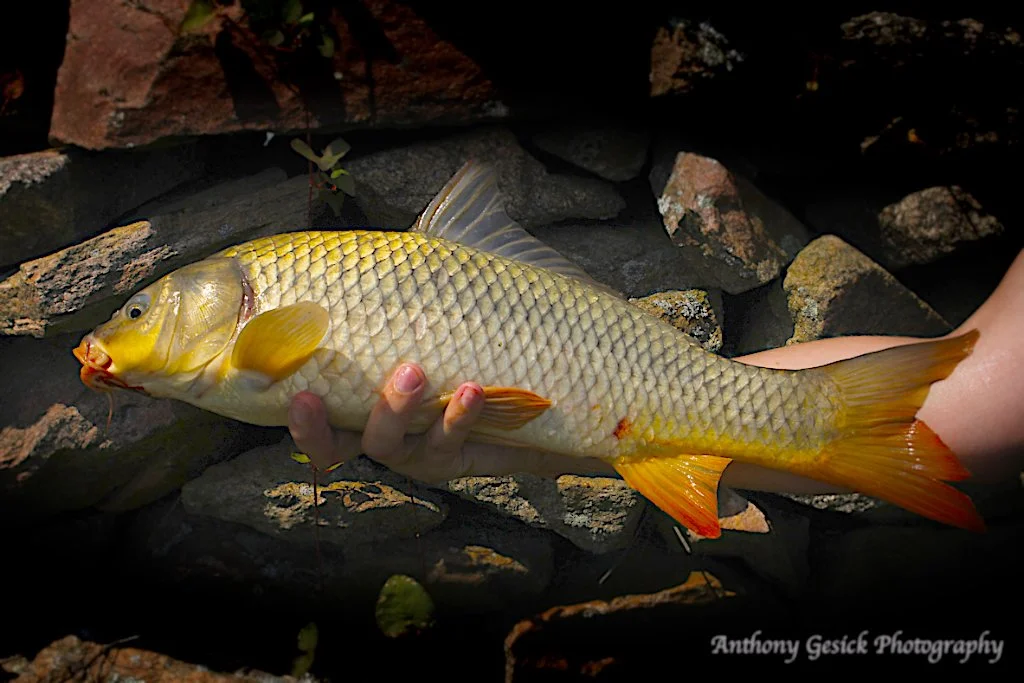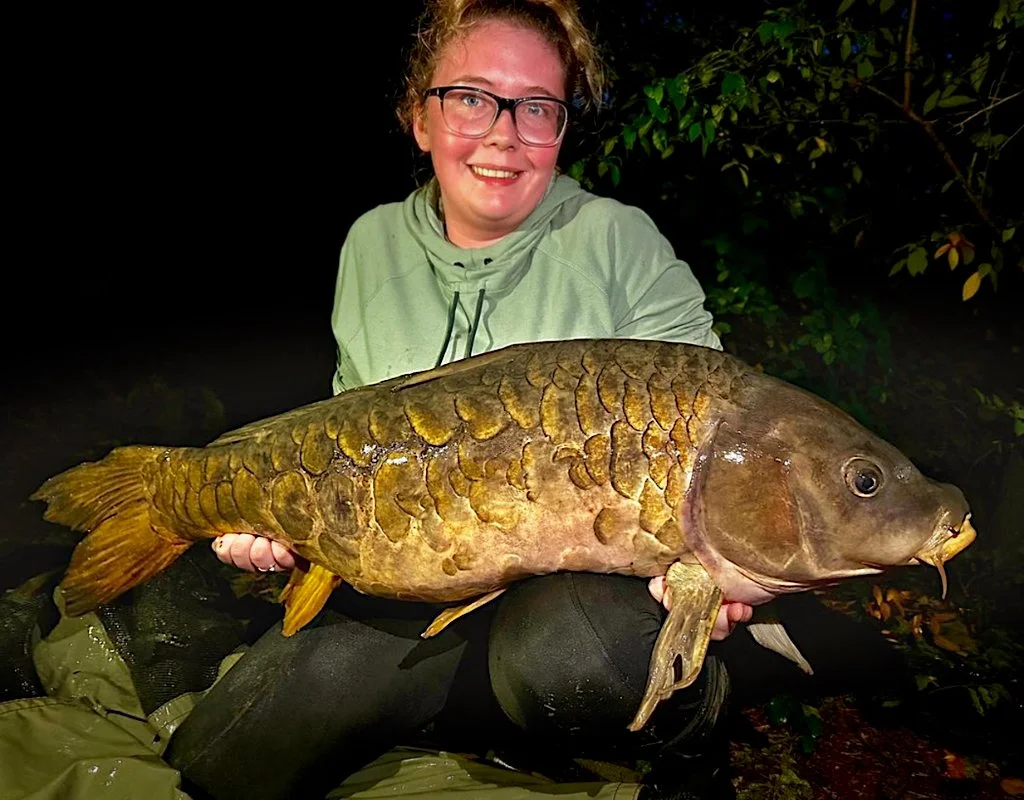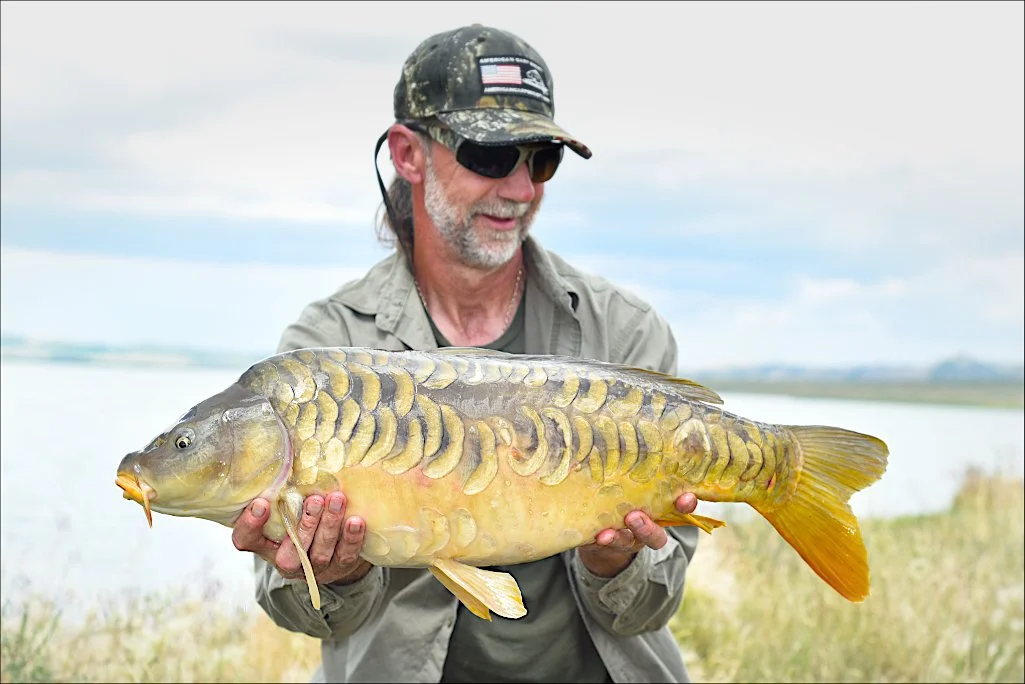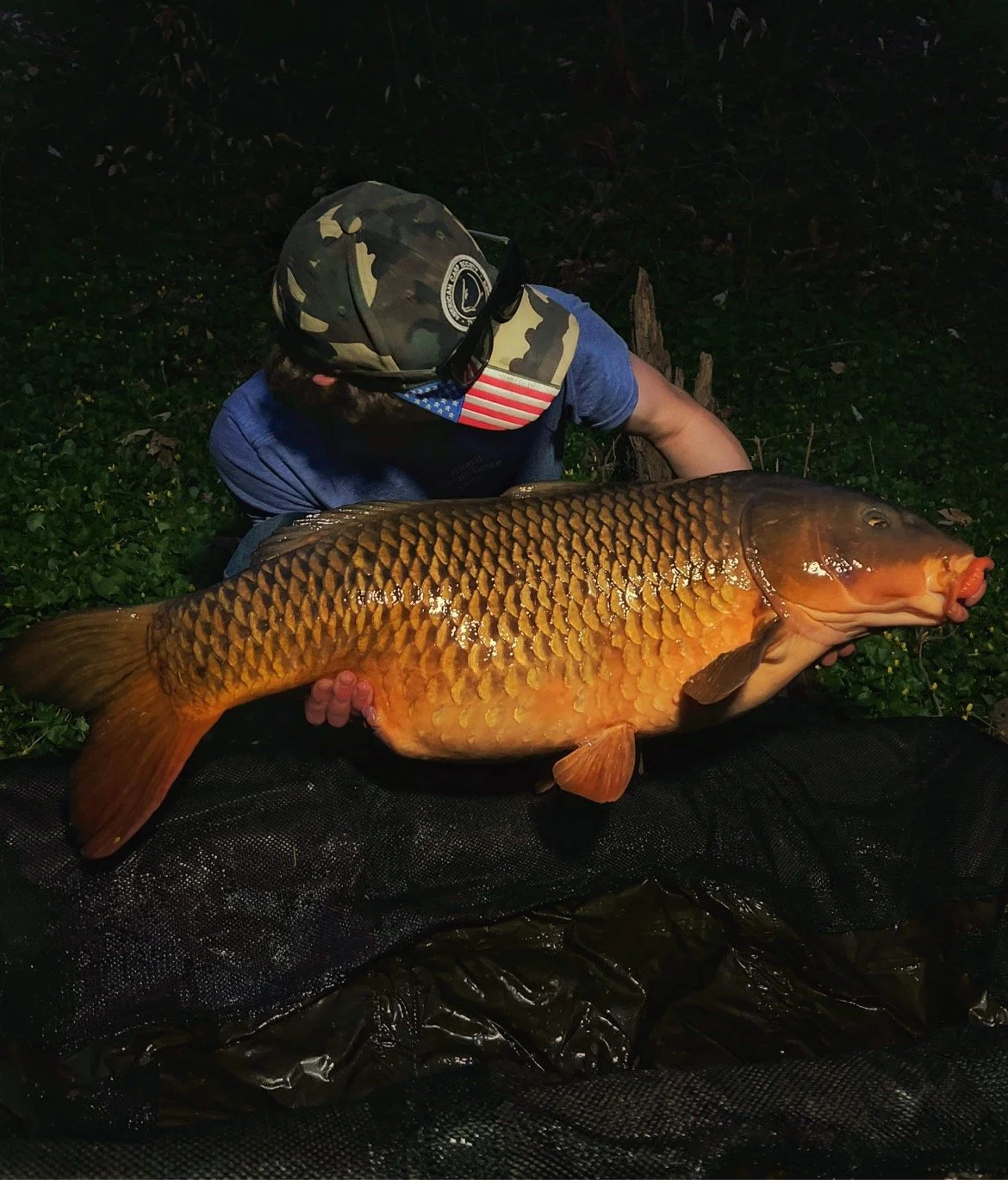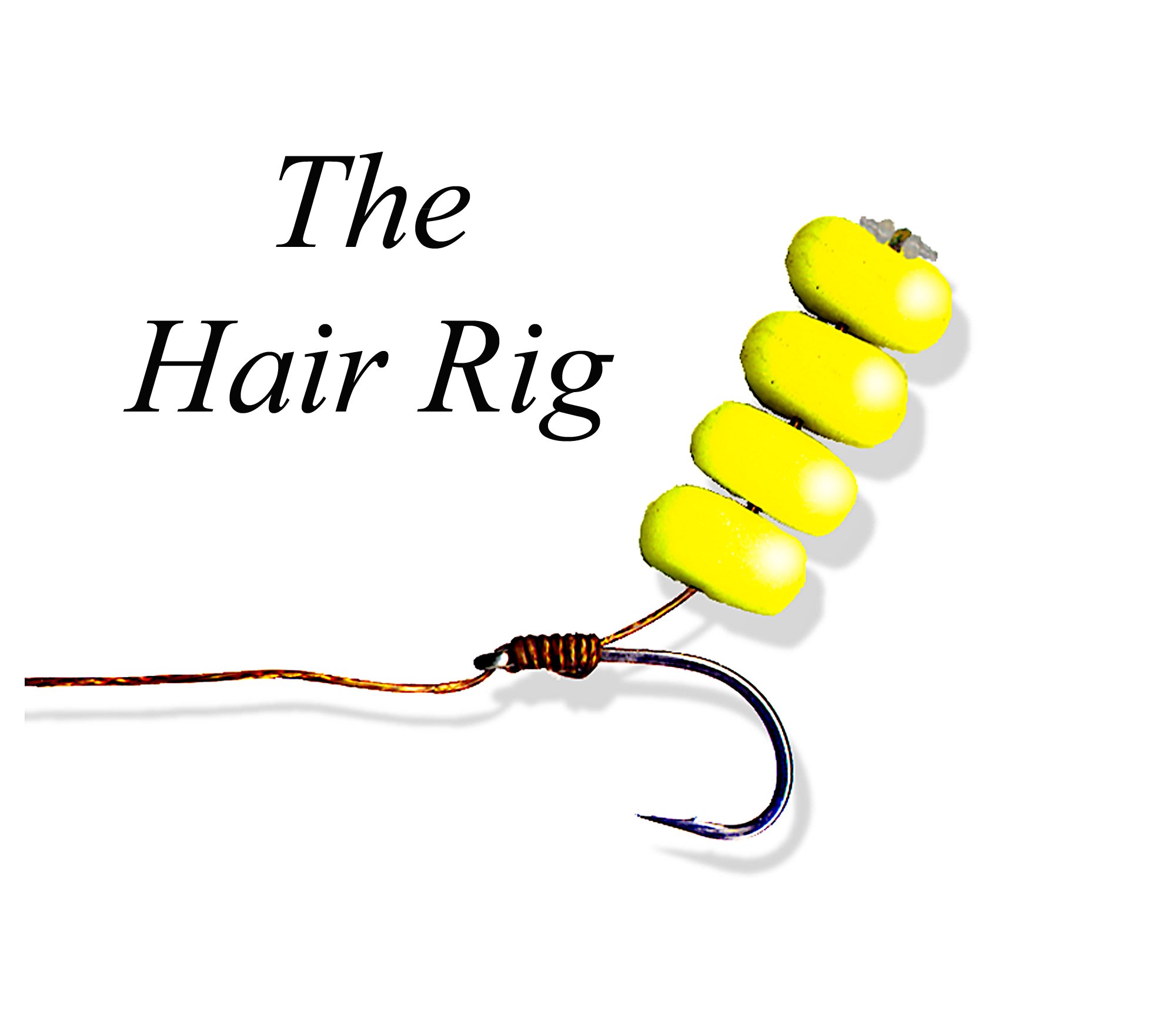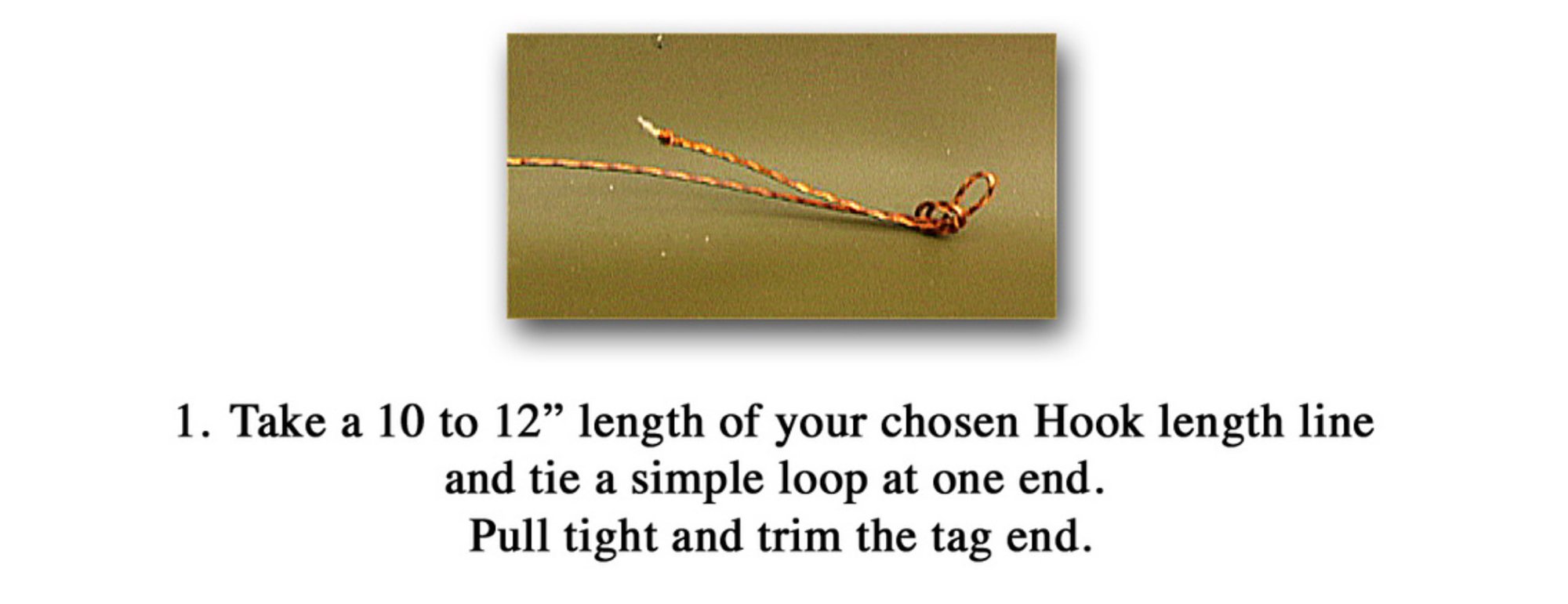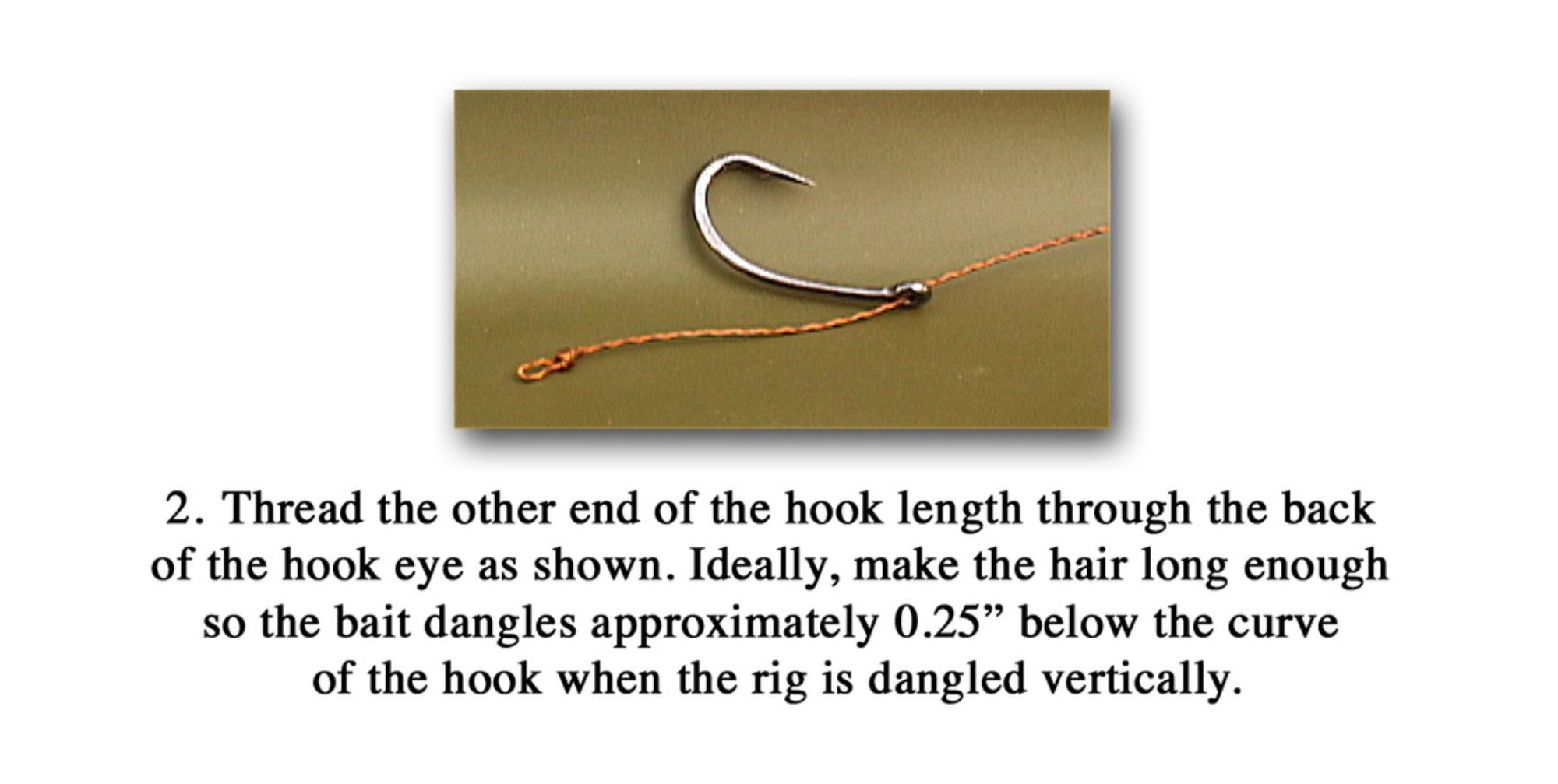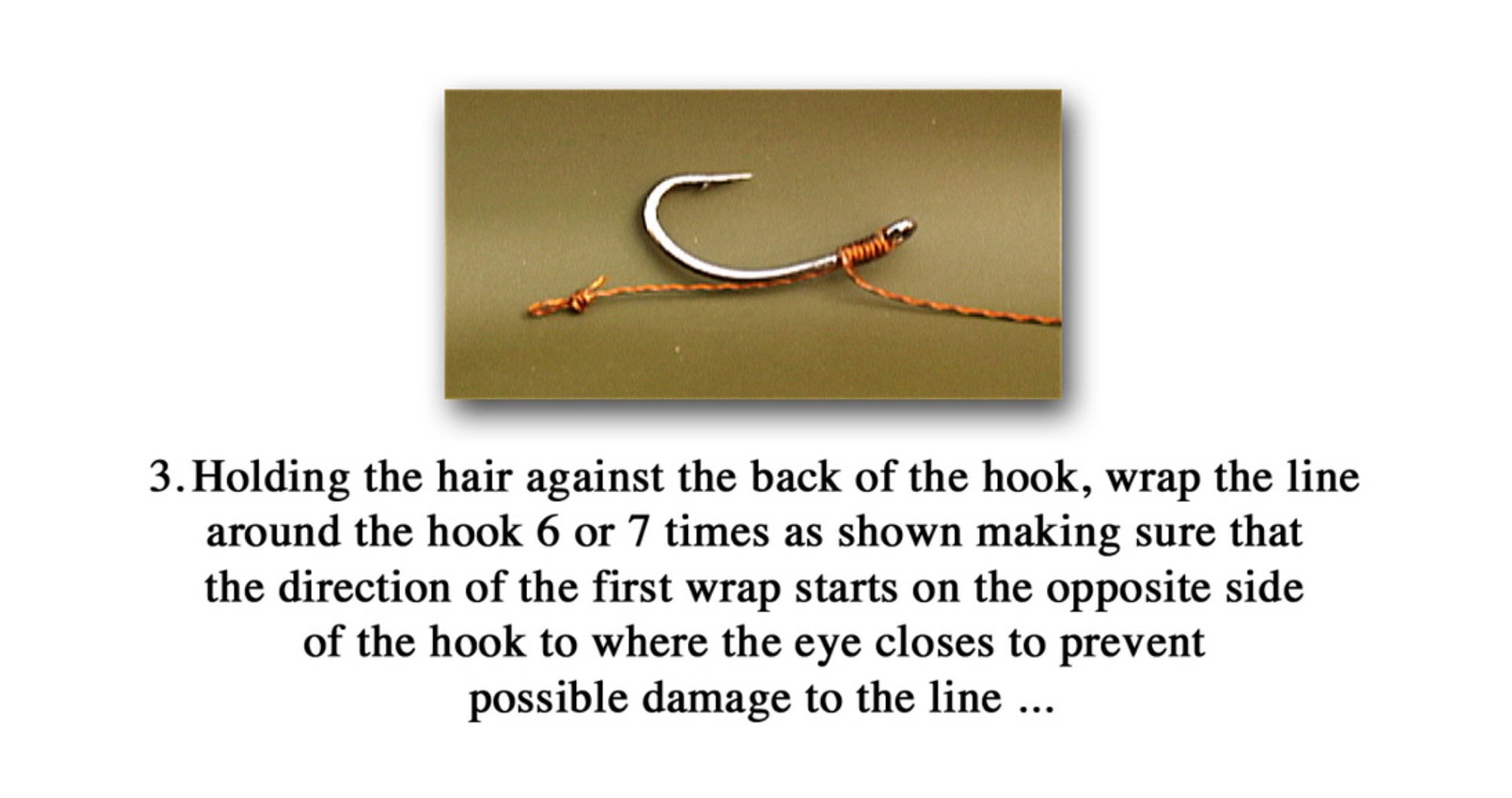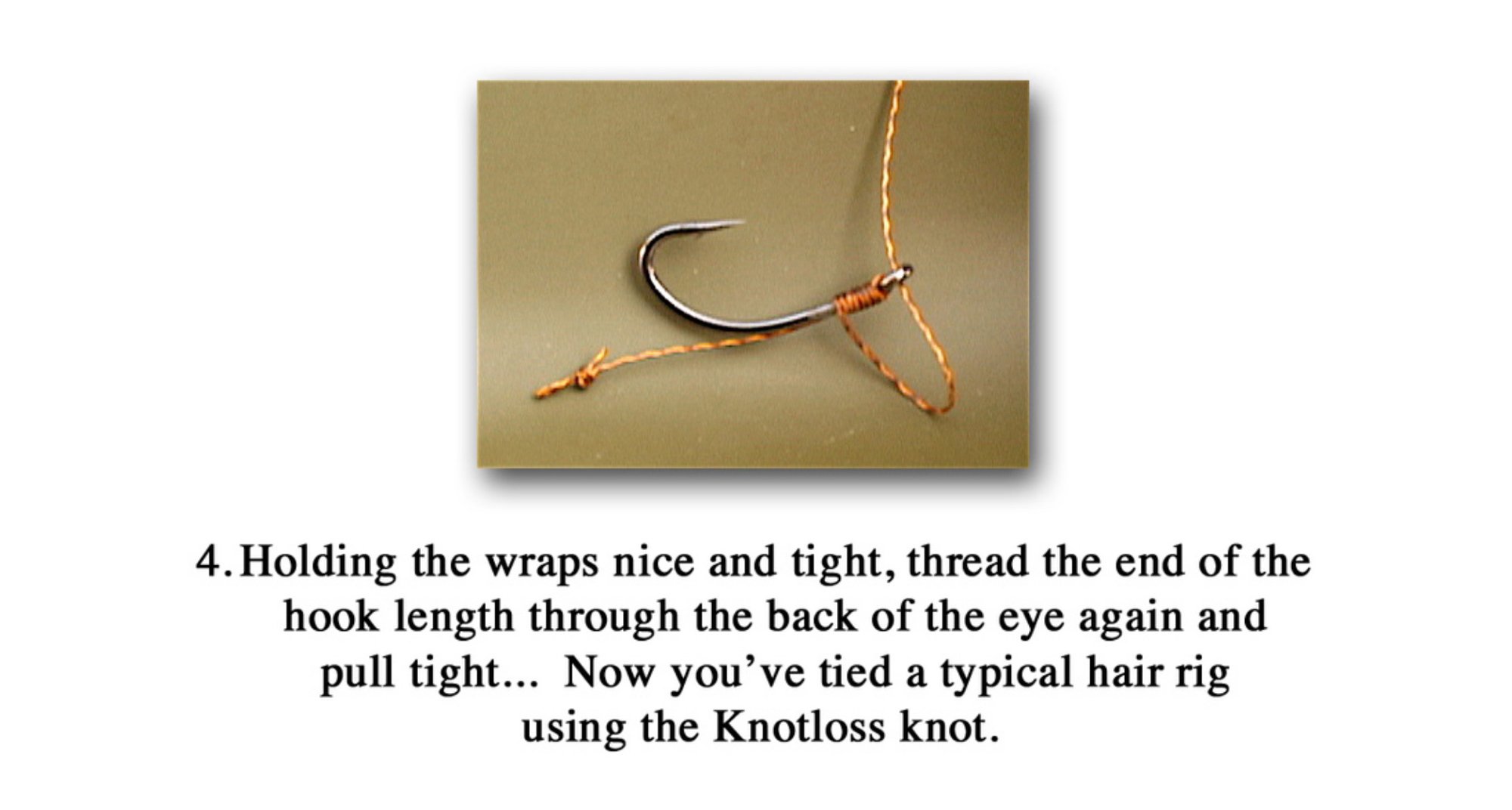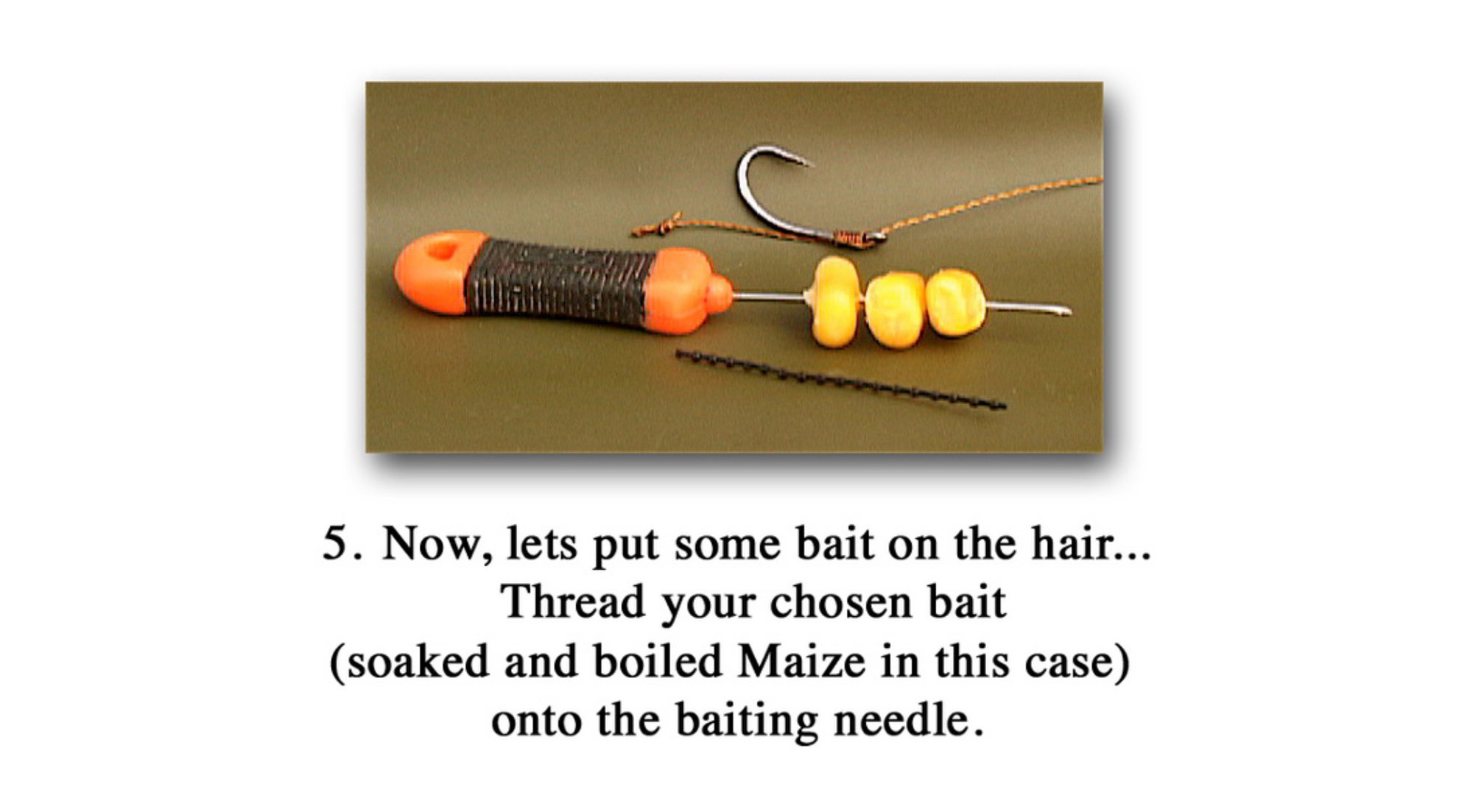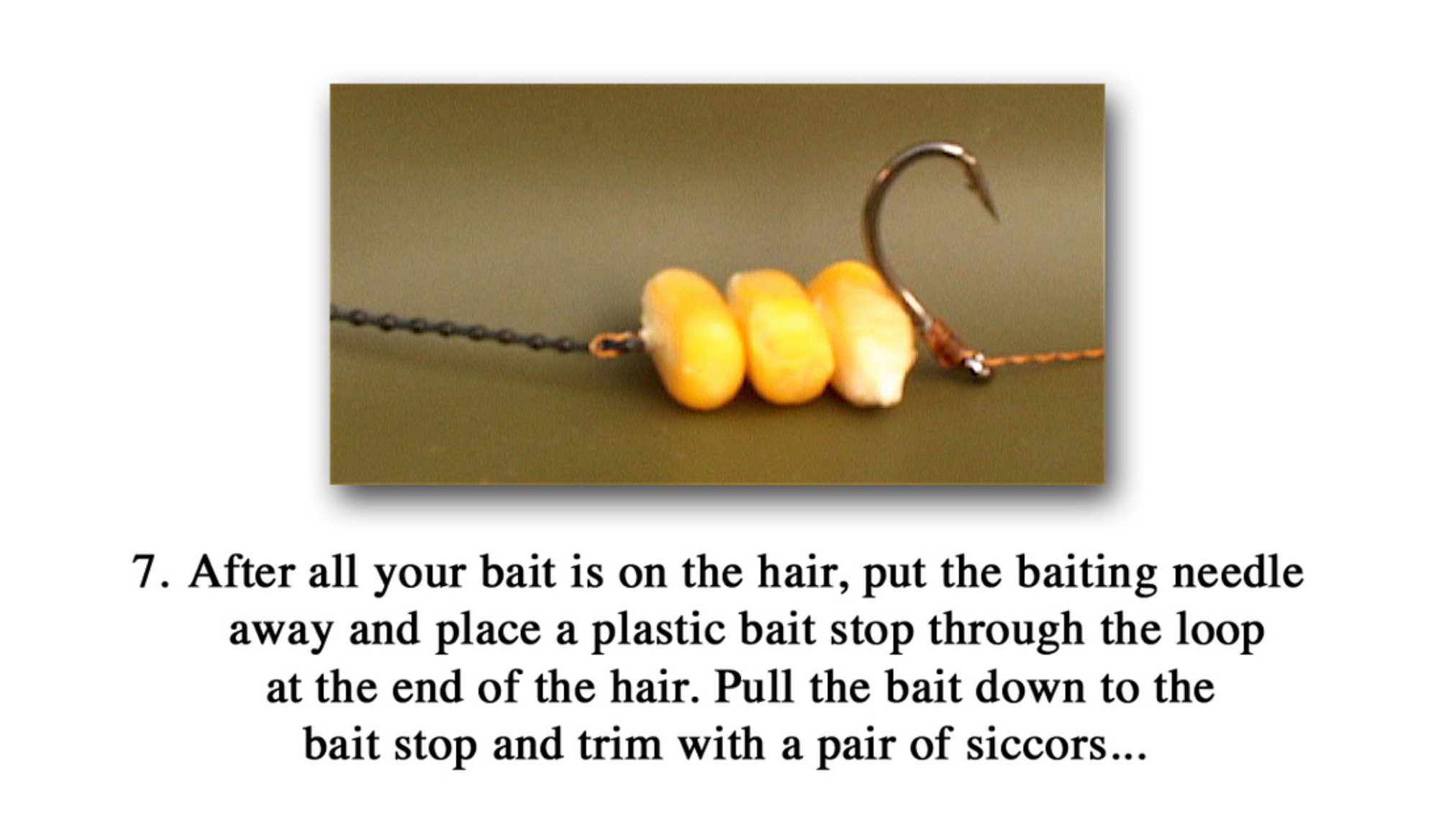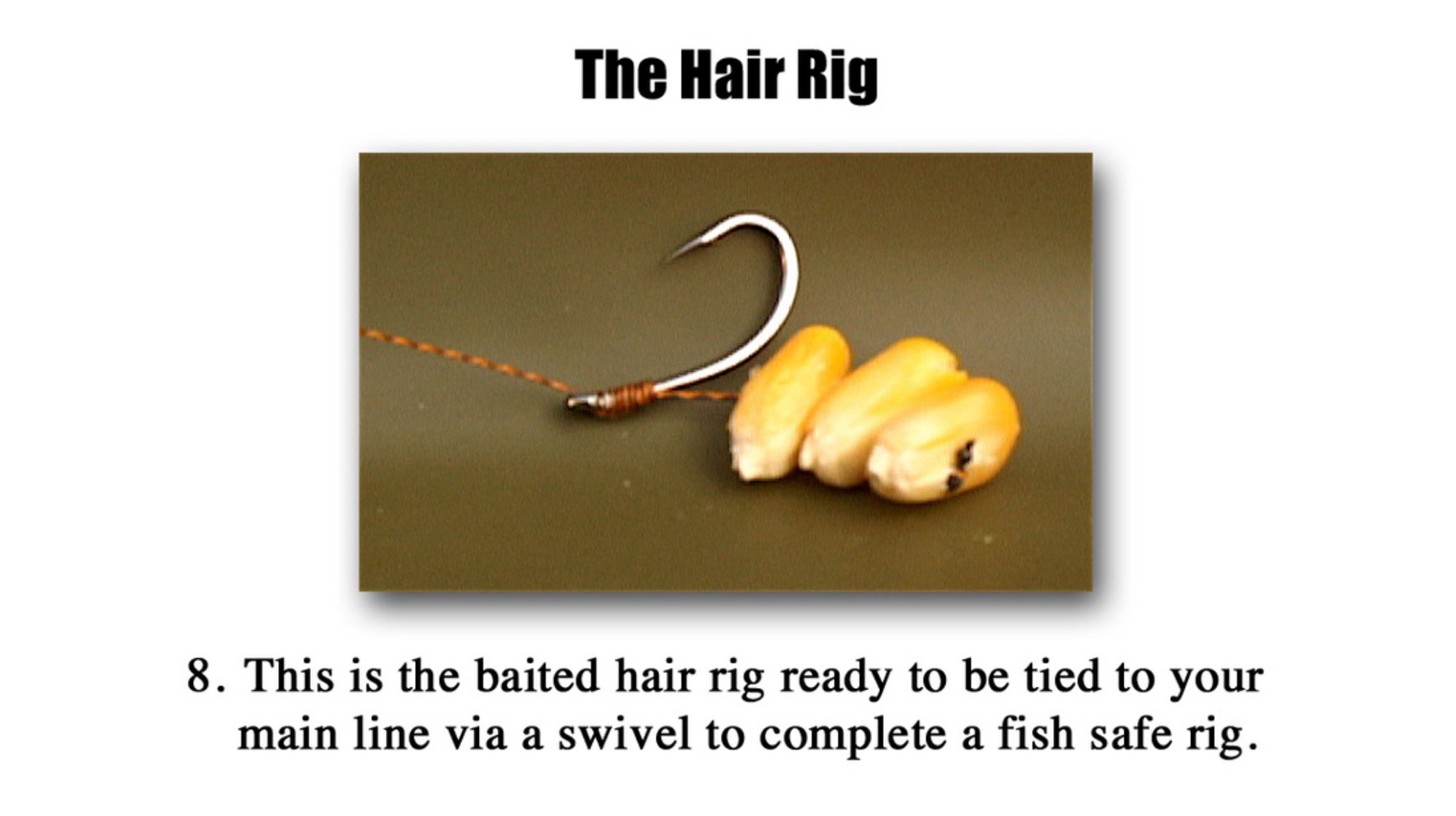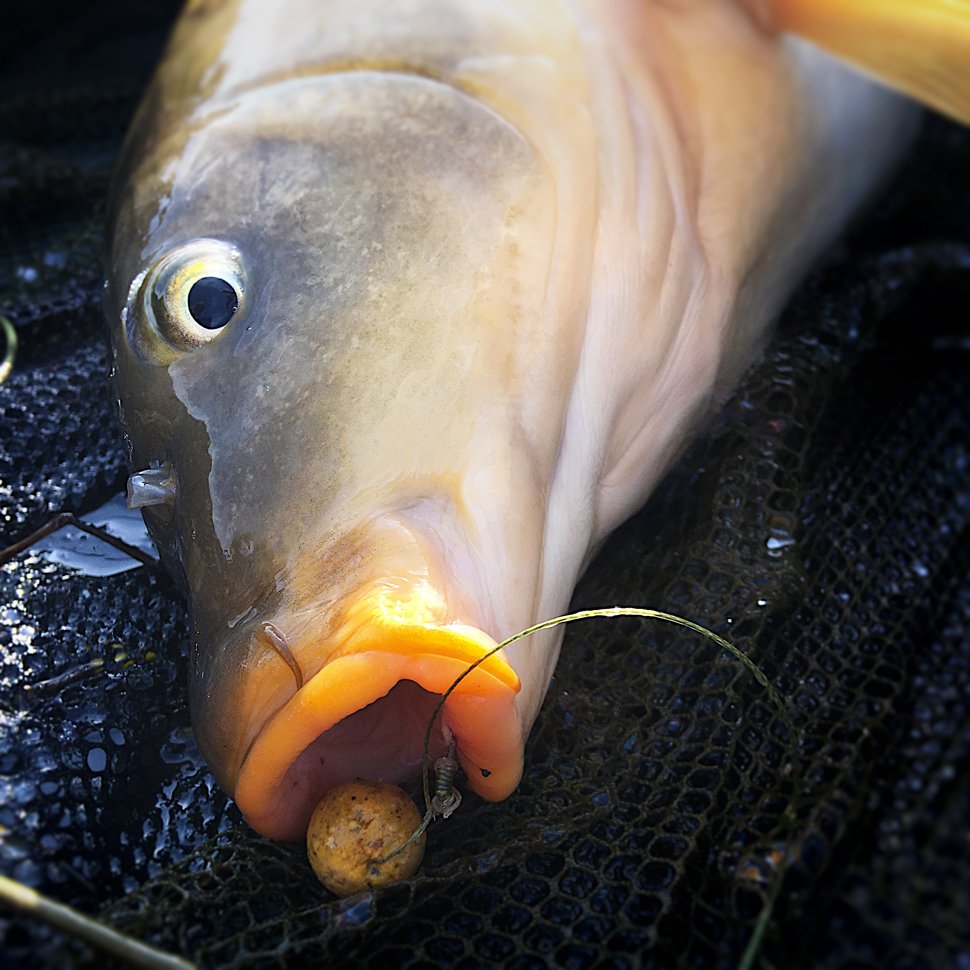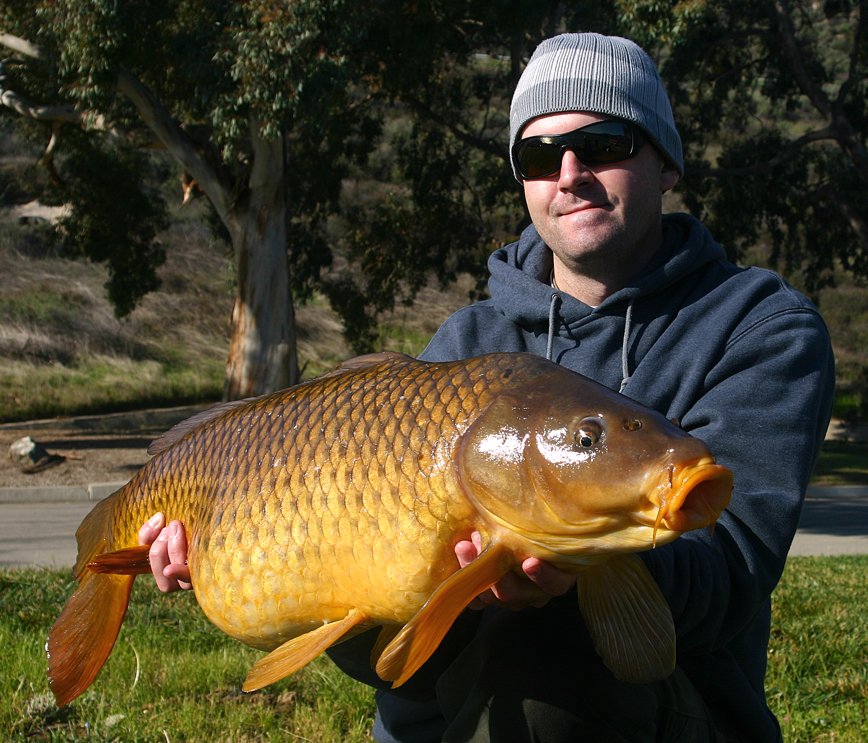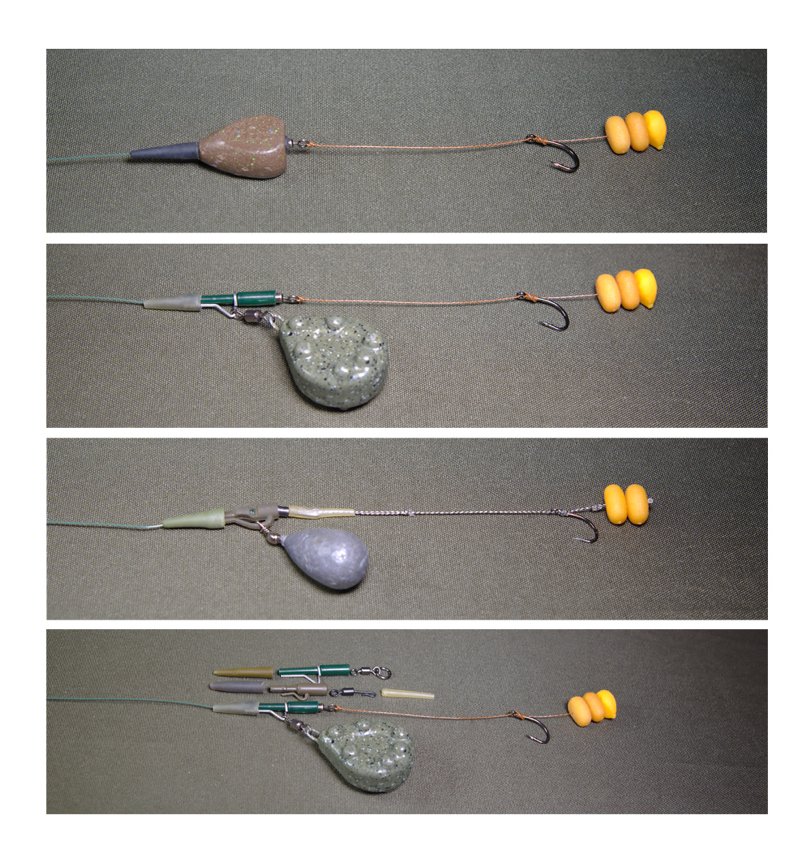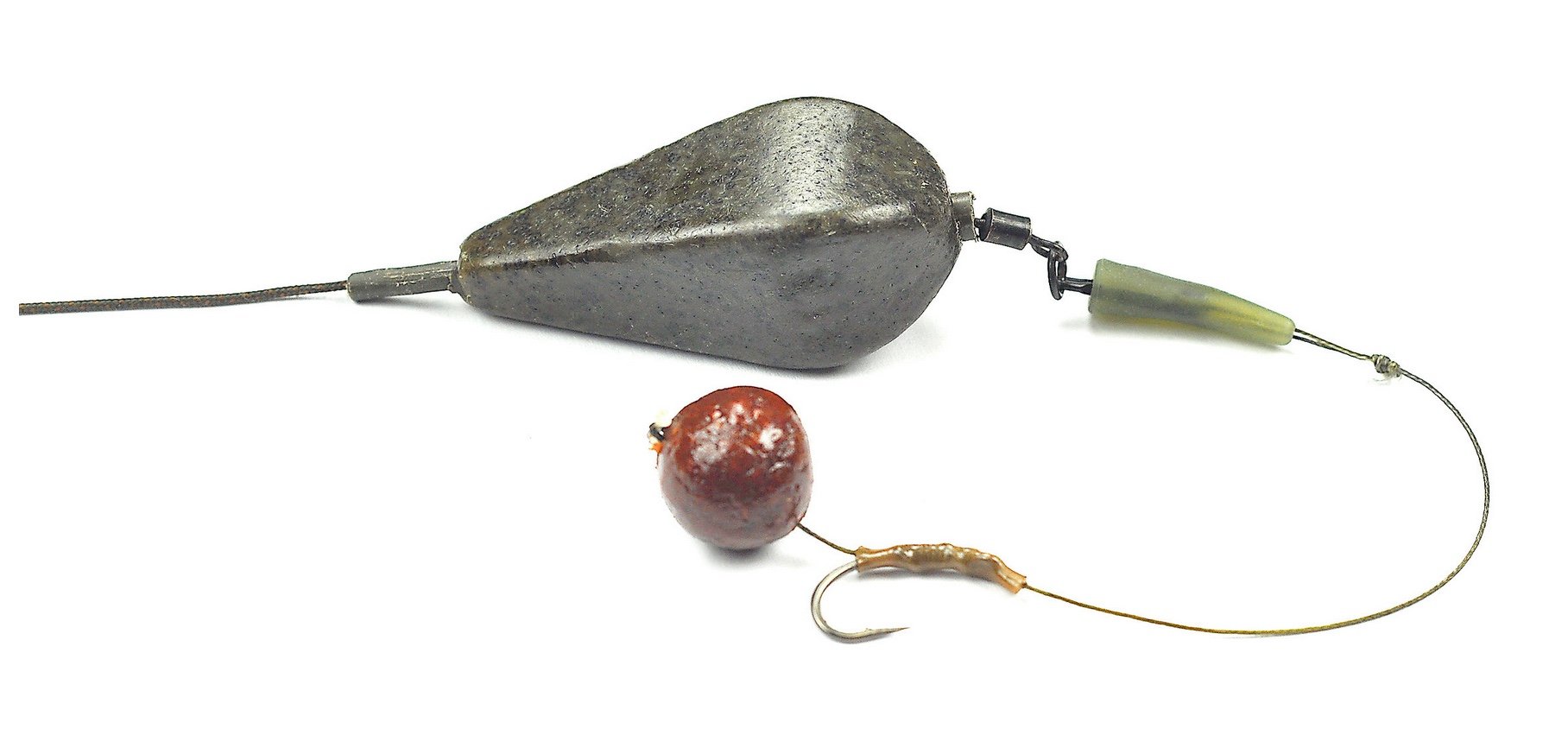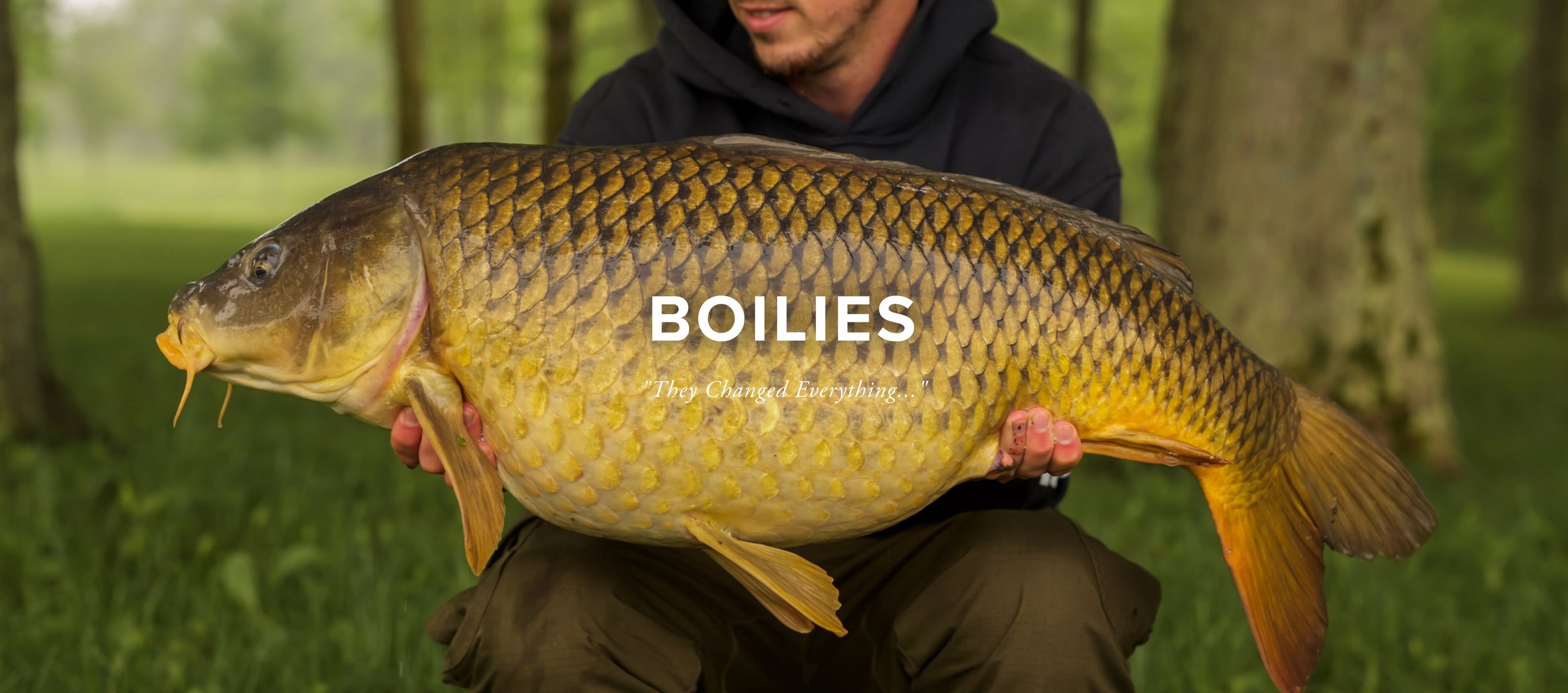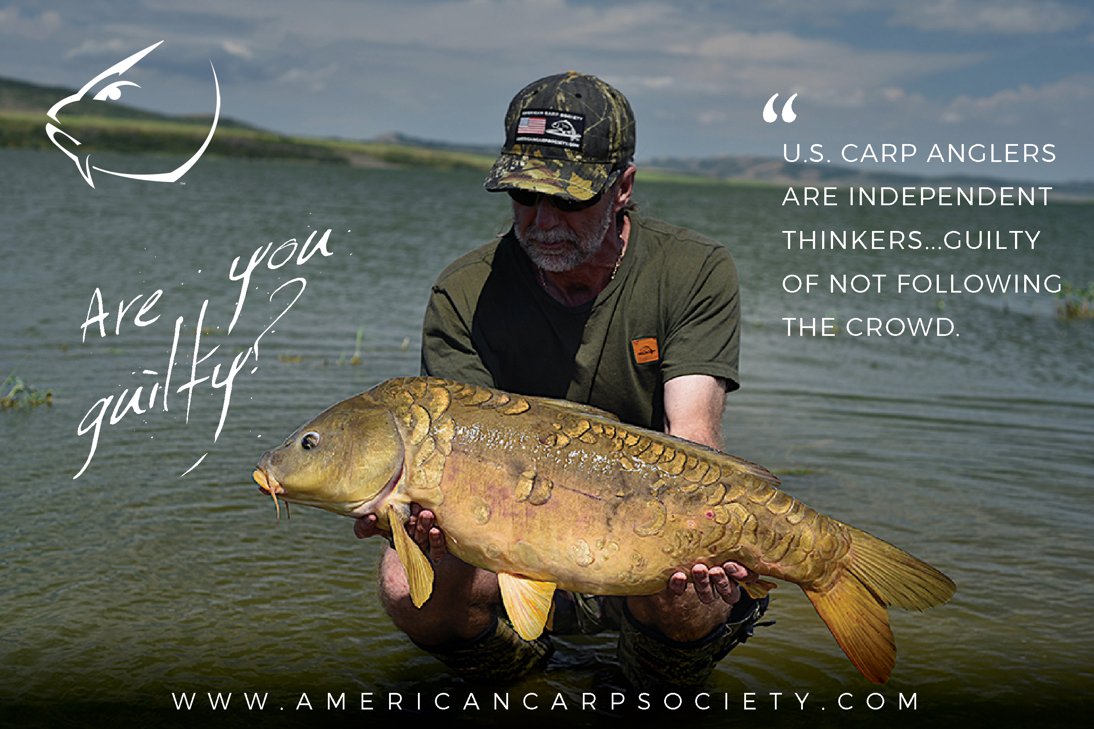Hi there, my name is Jake Hoy. I am from the beautiful state of Pennsylvania. Being in this state gives me the opportunity to fish for some giants. I have only been carp fishing for three years now and two years seriously. I fish euro style and I have fallen in love with it. It has changed my life for the better. I started off with my buddies Ryan Curran, Aidan Fioravanti and Jessica Day. And we started by using corn directly on the hook. As the months went by we grew our knowledge and learned the euro way of doing it from fishing with Carl over in the UK. It is because of these three that my love for carp fishing exploded and I couldn’t thank them enough.
Snow Carping in Kansas
Being my first blog opportunity and not being one of the cool kids in the US carp community, I’ll go ahead and introduce myself. Bear with me, I’m not an accomplished writer and I put thoughts together like a 5 year old that’s had sugar.
My name is Loren Walters, and I have a problem. I used to be perfectly happy spending hours of time endlessly chucking rubber worms to catch 13-inch ditch pickles and feeling happy to catch a couple pounds of fish. Unfortunately, I started hanging out with the wrong people.
One of my friends (Kevin Zirjacks) introduced me to what has become not only a hobby but is something that I cannot quit, carp fishing. After finally agreeing to do what I thought of as “trash fishing,” all it took was two fish for me to reevaluate my whole opinion on something I had been doing since I was seven.
It changed fishing for me completely. My second carp I had ever caught was 26 pounds!
The Fall Notebook
After struggling a good portion of the season fishing different areas on the river, It was nice to make the trip back to the lake with Triton my trusty Pit Bull companion.
Unfortunately, Northern California was impacted by a handful of storms that made certain areas almost impossible to access but one thing I've learned is to always have a backup plan, just in case your local fishing spot is no longer an option.
Normally around this time of year I would be covered in winter clothing and finding ways to keep my hands from freezing but at the time of writing, It was currently 105 degrees with no signs of fish.
Whispering Waters
My name is Adam Zahrt, my passion is educating about the ethical use of our great outdoors and natural resources. Especially on my YouTube channel “NorthMan Fishing.” My vision had for many years been to be the next great agriculturist of our time, and my grades matched the mission. However, the waters surrounded me, and whispered my name as I would pass by them in my daily endeavors. After all, I had been a hobbyist fisherman nearly since my inception. The call of the whispering waters intensified, and life became more than soil science and agriculture, life was a combination of fresh air, warm earth, and WILD WATER!
Rhode Island River Gems
Hi, my name is Austin Crawford and I enjoy most of my fishing time in my home state of Rhode Island. RI has so much potential for truly wild unique Carp! That’s why I really love fishing here because you really never know what’s on the other end of you’re line after the alarm screams. The fish here fight hard and are truly unique, every single one has its own scale pattern and battle scares of living in the wild river.
The Big Lake and It's Tributaries
If you live in the Midwest like I do, it’s hard to ignore the expansive bodies of water that would be within a few hours drive for most that live here, in the form of the Great Lakes. These lakes enormity can obviously be very daunting to think about how they can be fished effectively. Lake Michigan is the closest to me living in central Illinois, coming in at a whopping 14.3 million acres, would truly fit the ‘Inland Sea’ mantra in every sense of the analogy, unless you’ve seen them in person it’s tough to truly describe how insignificant you can feel standing next to one of them.
Why... Los Angeles Area River Carping?
I recently took a road trip back to visit Los Angeles and found my self walking a few of my old haunts/fishing holes and while I have plenty of fantastic memories, one of them brought back a gush of emotion. Not for the big fish but for the challenging and often extreme conditions/environment that the fish have to endure…tbh, it’s not so easy on the anglers either lol… So I got back home to East Texas and dug out a few LA River system carp capture photos that I had on my local hard drives…and here we are :)
Even though I’d lived and fished in the Los Angeles area for nearly 35 years, I’m a little embarrassed to say I don’t know much about the river systems at all… I say river systems because there are around half a dozen tributaries that run into the LA basin. One stretch in particular was a really handy stretch of water 10 minutes drive from my house that I visited to catch carp in the 3 to 10 lb range when I have a few hours free to fish. It scratched the itch, you know…
Pioneering Highland Reservoirs
In the winter of 2023, Northern California was hit with major storms and floods. My fishing partner Gerrod Winkler and I had to come up with a plan B because our usual Delta river spots were blown out. It was January, so we had to split up to target new water because the spring bite was fast approaching. We opted out of the smaller venues like park lakes and city ponds because we have no interest in recaptured fish, and in my opinion, larger venues are future proof as the sport grows. Gerrod chose to target larger Bay Area and central Valley Lakes while I chose to focus on the Seirra Nevada lakes and reservoirs. Large lakes in Northern California are ripe with unexplored Big Carp waters with 24/7 365 days a year fishing access.
Combat Carp Hate with Burritos
I’m sure most carp anglers in America have had to deal with their fair share of carp hating rhetoric. Most of it is ill informed, overblown, and ridiculous. None of it is very fun, which is why we fish, right?
One of the first times I fished a favorite lake of mine, the head county ranger of the park when hearing I was fly fishing for carp told me to “just throw the damn things on the bank and let them rot!”. For a variety of reasons, that was a very interesting conversation, not least for the fact that I’m pretty sure it’s illegal to kill fish just to let them rot on the bank, or at the very least morally and ethically just wrong. This rhetoric is also coming from the people getting paid by our tax dollars to protect the natural resources of the area. This is a lake inside county lands that doesn’t allow the hunting of highly invasive wild boar, but just killing carp for the sake of killing them is considered fine.
Big Waters, Big Fish
For me personally, nothing is more rewarding than catching fish out of a 2,300-acre reservoir with acres more surface water just waiting to be discovered... My surrounding area has a ton of water that will forever keep me looking for bigger and more beautiful carp. There are some reservoirs that I have not discovered yet that reach up to 4,000 acres… Plenty of exploring yet to do and that’s exciting!
My name is Brandon Curtis, I have been an avid carp angler for just a little over 3 years now and I’m located in the Southern California area. The amount of knowledge that I have gained with carp angling is incredible, it amazes and reminds me that anything is possible.
Is it Location... or the Bait?
Here is something to keep in mind, especially for the newcomers getting into carp fishing. How many times have you had more success or less where you set up in a swim twenty or thirty yards from the next carper, and he was or wasn’t doing better than you?
Do you think it was his bait? Or was it the location?
If your bait is time-tested and you have complete confidence in it, then it is location most times you aren’t catching fish. I fish nothing but method feeders and a pack bait formula that has worked on a couple thousand carp, plus fake corn on my hair rig, if carp are active, I’m going to catch some.
Notice I used the word active, if they aren’t active, they won’t bite. I believe some fishermen think fish eat all day. This is so far from the truth. Nothing alive feeds all day. So many factor contribute to fish activity.
Chasing Autumn Gold
Autumn, what a wonderful time of the year to be an angler. The leaves begin to change their colors, temperatures start to drop giving you the crisp cool mornings. The carp start into their fall routines, feeding more vigorously to sustain that winter weight. It’s a great time of the year to be out chasing them gold scales, and that’s exactly what I did over a span of a few weeks in October. My journey had taken me to some wonderful places, fished with family and friends, had my share of highs and lows, and of course a carp or two.
Life On The Bank
Hi, my name is Mykayla Swartout and I am a angler in upstate New York. I have always been an angler but within the last few years I’ve become solely a carp angler and that’s what I find myself targeting year round. Where I'm from there are so many fishing opportunities and as I come across new places up here I realize there are so many magical places to carp fish. Rivers, reservoirs, ponds, etc.
Fishing The Unknown
The San Joaquin River has three major tributaries: The Merced, Tuolumne, and Stanislaus rivers. The Cosumnes (a tributary to Mokelumne River), Mokelumne, and Calaveras rivers also flow into the San Joaquin where the river joins the tidally influenced "Delta" This large body of water covers just over 1,150 square miles or nearly 73 percent, devoted to agriculture farm land. How do i fish a location like this? I guess the better question is, Where do i even start?
USA Carp Angling Intro - Part 6
Basically, what we’re trying to do when “fishing the Method” is to create a very competitive feeding situation for the Carp in the area we’re fishing. You’ll often hear the term “pre-occupation,” this is just one in the same thing really. The Carp are so busy competing with each other for the morsels of food you’re presenting that they tend to make mistakes and get themselves hooked…
Note: Please check with your local Fisheries Department to make sure pre-baiting or chumming is legal in your area before employing this tactic.
So, that begs the question, how do we get them into this frenzied state and force them to make an error?
USA Carp Angling Intro - Part 5
Welcome to the 6th article by Wayne Boon of the American Carp Society designed to introduce and instruct anglers on the new age of Carp Angling…
This month we’re going to cover another very useful carp fishing technique that many of us are already familiar with when fishing for other species. Fishing with a Float or bobber can be one of the most thrilling techniques for catching carp. We’ll be adding quite a few refinements to the float rigs that you probably already use that could very well benefit you when float fishing for other species too…
Ok, lets get into it and look at how to use these float fishing techniques to catch more Carp (cyprinus carpio).
USA Carp Angling Intro - Part 4
Hello and welcome to the 4th article designed to introduce and instruct anglers on the new age of Carp Angling…
Over the past 3 articles, I’ve covered some basic carp behavioral traits, baits, rigs, fish safety & conservation techniques that are employed by today’s world wide carp angling community.
This month, I’m going to go back to the topic of baits and introduce a product/presentation technique that not many folks outside of carp anglers will have used or even heard about…
USA Carp Angling intro - Part 3
Hello again and welcome to the 3rd article in this series designed to introduce and instruct anglers on the new age of Carp Angling…
We’ve recently covered many of the basic concepts and techniques commonly employed to catch carp; this month, we’ll take a really good look at fish safety which is always uppermost on our minds when ever we are fishing, regardless of specie we’re chasing…
There are two main aspects:
Fish Safety while actually angling.
Fish care & safety while the fish are in our possession; That is, while they’re out of the water for as brief a period of time as possible while we un-hook, measure, photograph before returning them to the water…
Pennsylvania PB's
Hello my name is Will Passaretti and im a carp angler from Pennsylvania. The state has many great opportunities for fishing whether it's fly fishing for trout, throwing lures for bass or targeting these bars of gold. I started targeting carp back in the fall of 2019 after I realized that the local pond I was fishing had some giant carp in it. I had always been an angler and mainly targeted bass but after accidentally hooking one I realized I should attempt to legitimately hook one. I tried several times before I managed to finally hook one. After several minutes the fish slipped into my net and a new addiction was born.
USA Carp Angling intro - Part 2
Hello again and welcome to the 2nd article in this series which is designed to introduce and instruct anglers of all persuasions on the new age of Carp Angling…
We’ll start this month with what is without a doubt, one of the biggest advancements in carp fishing in the last 40 years!
As you may already know, with a few amendments to our approach and existing tackle, carp can be caught by placing bait directly onto the hook and striking on the 1st signs of a line twitch. This is good for catching young carp who are inexperienced and well, shall we say, “carelessly hungry…” but as carp grow up into the 20 and 30 lb plus bracket, they become very much more learned and picky about both what they eat and how they approach finding and eating their food.
So… What is the biggest advancement in carp fishing in the last 40 years that will help us actually hook and land more carp?
It’s simply a method of baiting your hook that takes full advantage of how a Carp feeds…..it’s called a ‘Hair-rig’ and we gave a few sneak peeks at in the some of the rig photos last month.
The hair-rig specifically targets and takes advantage of the way a Carp feeds. When the hair-rig is tied correctly (as described below) so that the hook turns during pick-up, it safely hooks 99.9% of the fish in the bottom lip. At first (in the mid-70s in the UK) it was literally a human hair tied to the bend of the hook that had the bait mounted onto it; later, a very thin filament link was used.
When the super easy to tie, knot-less knot was invented to make a hair rig, it again revolutionized Carp angling because it offered a way of both producing a hair and securely tying the hook to the hook length line with one very strong “knot” without any strangle points on the line being used to tie the hair.
The Hair Rig is the foundation of most carp rigs these days and use various hook length materials, rig rings, shrink and silicone tubing to make them even more effective in many varying fishing conditions. Even in its simplest "naked" form shown below, it is a game changer for the angler who learns the mechanics and how to tie it effectively.
Note: In an emergency situation, you can make your own baiting needle by carefully heating and straightening out the hook section of an old Crappie jig head (see photo below) and you can use a short section of grass stalk or a thin twig to replace the plastic bait stops.
The mechanics of the hair rig are as follows:
Carp feed by sucking any potential food item along with much of the sand, sticks, mud etc. that's laying or floating around the immediate area into its mouth to inspect, before blowing it all out. Then often recapturing the food item quickly if it is a desired or needed by the Carp's metabolism. Carp rarely swallow the food item on first inspection, this is particularly so if it's not a recognized, naturally occurring and familiar food source in their lake/river, so this can happen several times before a decision is made to eat your bait. Carp are so efficient and stealthy at this process, that it very often happens without so much as a single bounce on your rod tip or movement of your line. Many blank or Skunk sessions have been declared by anglers who have had their hook-baits stolen or just simply picked up and spat out several times. This is even more prevalent when bait is placed directly onto the hook…
Not having hands and fingers to inspect the potential food item, this is how Carp learn. They have many taste sensing cells/sensors are in and around the mouth area and these sensors are how a carp learns about the food item, even sensing its calorific make-up (Carbs verses Proteins and minerals etc.) They are also instinctively inquisitive creatures and we can often use this to our advantage too. So, knowing these facts, helps us visualize how a Carp feeds and how better to tie an effective hair rig.
Let's now look at the actual mechanics of the hair rig. As can be seen from the above photos, the bait hangs below the bare hook. When the carp sucks in the bait, it will suck in the hook also, quickly followed by the carp blowing out the bait.
Next, because the weight and bulk of the bait offers much more resistance than the hook in the torrent of water exiting the carp's mouth during this "blowing out" phase of tasting process; the bait exits the mouth attached to the hair first dragging the hook behind it. The hook then pricks the bottom lip of the carp.
Therefore hooks need to be "sticky" sharp when carp fishing because this light prick in the carp's lower lip will stop the hair rig from being fully ejected. The fish will then panic and what we call “bolt” (like a horse getting spooked and bolting off across the field) giving that precious few seconds for us to strike and set the hook properly.
SoCal’s Evan Bull with a beautifully proportioned hair rig caught common.
To take extra advantage of this "Bolting" phenomenon, keep reading and we’ll explain what is known in the carp angling trade as a bolt rig, which is another tactical advantage that can be incorporated in conjunction with the hair rig to great effect.
The Bolt rig is designed to take full advantage of the Hair Rig's self-hooking properties and vastly amplify it. It does this by effectively adding a "dead weight" to the point of the hook, thus sinking the hook deeper in to the bottom lip, achieving a good hook hold when the fish bolts upon initial contact with the point of the hook. This "dead weight" is achieved by the attachment of a semi-fixed lead weight of anywhere between 2 and 5 ounces fixed via a specifically designed clip and swivel system threaded onto the line just above the hook-length as opposed to the sliding or running rig lead weight system we looked at last month.
Note: NEVER tie the sinker/weight directly to the mainline to create a bolt rig. This would almost certainly sign the death penalty for the fish in case of a line breakage. Use either the in-line weight or attach the weight via one of the safety clips shown below as these are specifically designed to jettison the lead weight in case of line breakage during the fight.
As the images below shows, the bolt rig can be tied and presented 2 two ways: • As an 'in-line' lead weight but still carefully designed and constructed so that the lead weight can pull away in case of a break, so ensuring the safety of the fish. (See the 1st photo shown below).
A lead weight with swivel connected to the line via a safety clip as shown in the 2nd, 3rd photos; the 4th photo shows some alternative, component parts.
By combining the mechanics of the hair rig above with that of the Bolt rig: The fish sucks in the bait, and attempts to spit it or moves away with the hook bait in it’s mouth. The bare hook pricks its bottom lip and the carp “bolts” off. Now with a heavy semi-fixed lead in place, as the fish bolts the weight of the lead pulls the hook more firmly into its mouth and the fish is well and truly hooked before you have even seen the bite.
So instead of having to practically sit on our rods to hit runs that typically stop quickly when you're using the sliding/running rig, we can now take our time and gently lift the rod up to feel the strength of the carp that is already well connected to the other end of the line. The next phase of the capture begins; the skill needed to land and overcome the carp's infamous, encyclopedic knowledge of its underwater surroundings, including all the local snags along with its shear, unadulterated pound for pound fighting power…Good luck!
To complement the hair-rig, and to get you out and catching some carp lets finish off this month’s segment a brief talk about a couple of the baits; both hook baits and a good pack bait that are typically used.
Hook baits:
To some of you reading this it may seem like we’re stating the obvious here but never the less, the following bares mentioning for those that are completely new to Carp Angling.
Probably the best universal hook bait out there for carp is canned Sweetcorn bought right off of the shelves of your local grocery store. The only negative is the fact that sweetcorn is soft and so can sometimes come off the hook or hair when casting or other smaller species of fish can nibble the sweetcorn, eventually leaving your hook with no bait.
Maize when prepared correctly can solve these problems…
Field Corn/Maize bought in 25 or 50 lb bags from a feed store can also be extremely successfully when used on the hair as long as a few extremely important rules are strictly followed:
Egg sinker running lead/hair rig
The dry Maize MUST be soaked in a bucket of water for at least 36 hours to fully hydrate.
Then it MUST be vigorously boiled for 35-45 mins to soften them up and to release all the natural sugars/amino acids contained within the Maize kernel. This soaking and boiling process makes the Maize not only safe for the fish to eat but also turns it into a nutritionally useful food that contains some pretty serious feeding triggers and stimulators.
*Please DO NOT skimp on the preparation processes mentioned here in this section.
Next we’ll talk a little about boiled hook-baits, commonly referred to as boilies.
Boilies are hard-boiled baits that were originally introduced to carp angling in the UK during the late Seventies with the sole purpose of keeping 'nuisance' fish from eating away the bait being presented to the Carp…There have been many theories over the years regarding boilies, their use, nutritional value and importance to the carp angler’s toolbox. There’s no doubt about it though…. the right boilies made with highly nutritional ingredients do seem to separate the bigger fish and have accounted for many PB (Personal best)/Landmark Carp captures for anglers.
Very simple boilies can be made at home from eggs and whole-wheat flour, semolina and corn meal with some flavoring thrown in for good measure. These baits are rolled into various size balls and then boiled for 2 to 3 minutes dependent on size to form a tough skin on the outside of the bait. A quick google search will offer up plenty of both home made recipes and commercially available mixes and finished products.
Boilies come in a whole myriad of flavors, buoyancies, shapes, colors and sizes with nutritional values ranging from ‘Candy Bar’ to ‘Power Protein Shake.’ We mention this because over the years there has been great debate as to the importance of the ‘nutritional value’ of the boilie and the correlation between ‘how good’ the bait is for the fish and the ‘success’ of its catching abilities.
Pictured below are some home made and commercially produced Boilies ranging in size from 26 mm down to 8 mm that we're currently fishing with...
Boilies are commercially manufactured by companies the world over such as Solar, Dynamite, Nash, Mainline, Richworth, Nutrabaits, Rod Hutchinson and many, many more... There are some good bait and boilie making companies springing up here at home in the U.S.A. too such as CarpBaits-USA, Proline Baits, New England Carp Connections, World Classic Bait and Carp Maxx baits to name a few…
Of-course, we would be remiss if we didn’t do a little self plugging here and mention our very successful ‘Barnaby’s Revenge’ Range of boilies, Tigernuts and plastics that are available on our website’s store. https://americancarpsociety.com/store
Note: Boilies are also mounted onto the hair-rig with the help of the baiting needle we mentioned earlier.
The subject of boilies is very deep and this is as far as we will delve into it today…
Pack-Bait:
There are many recipes out there including our own “Ground-Bait” but one that stands out as both easy to mix and very productive in attracting Carp year round, is Cream Corn Oats:
Poor the contents of a large tub of Quakers Old Fashioned breakfast oats (approx 2 lb 10oz) purchased from the grocery store into your bucket (don’t used the 1 minute quick mix version).
Then mix 1 can of Cream Style Corn into the oats and thoroughly stir, place lid on the bucket and let it set for 10 to 15 minutes while you tackle up at the lakeside.
This Cream Corn Oats pack-bait is molded tightly around your sinker or lead weight before casting out. Once the pack-bait has hit the bottom of the lake you’re fishing, it starts to break down into a very nice attractive pile of oats and cream corn around your baited hook.
Here are a few photos showing a couple of Oat pack-bait mixes molded around the sinker/lead weight and lastly, a nice Common Carp cleanly and safely hooked in the bottom lip when it all comes together.
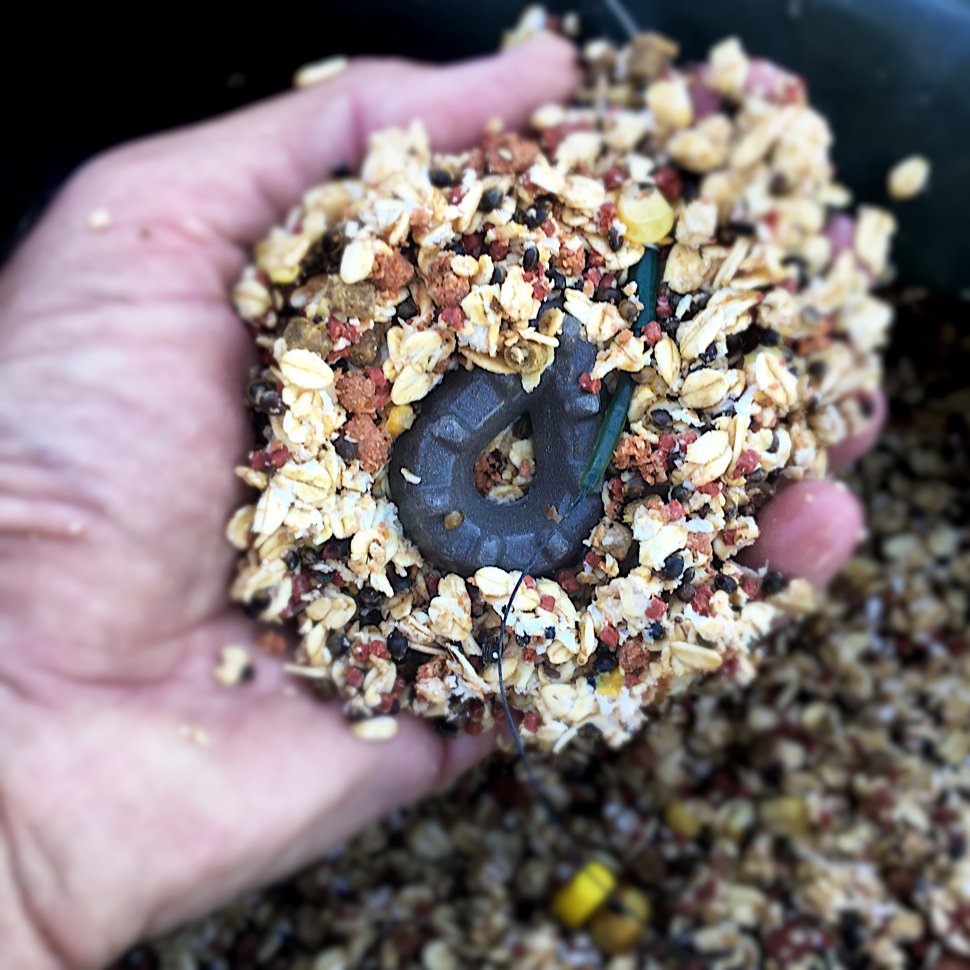
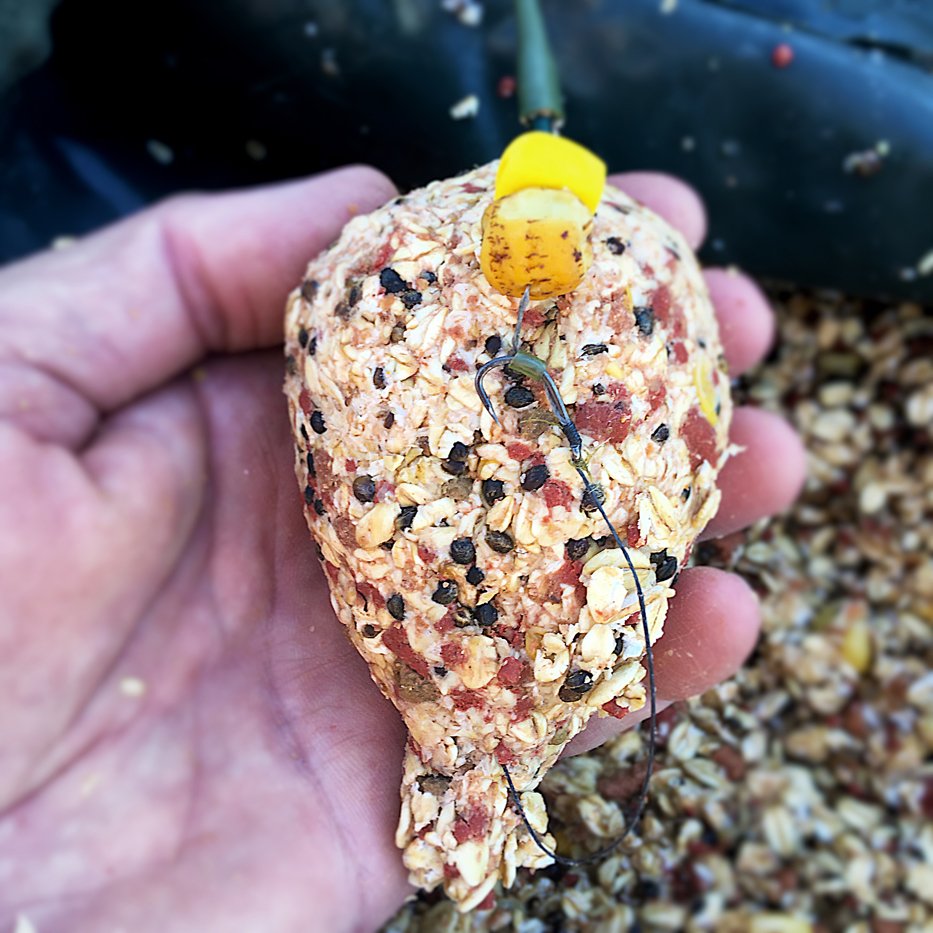
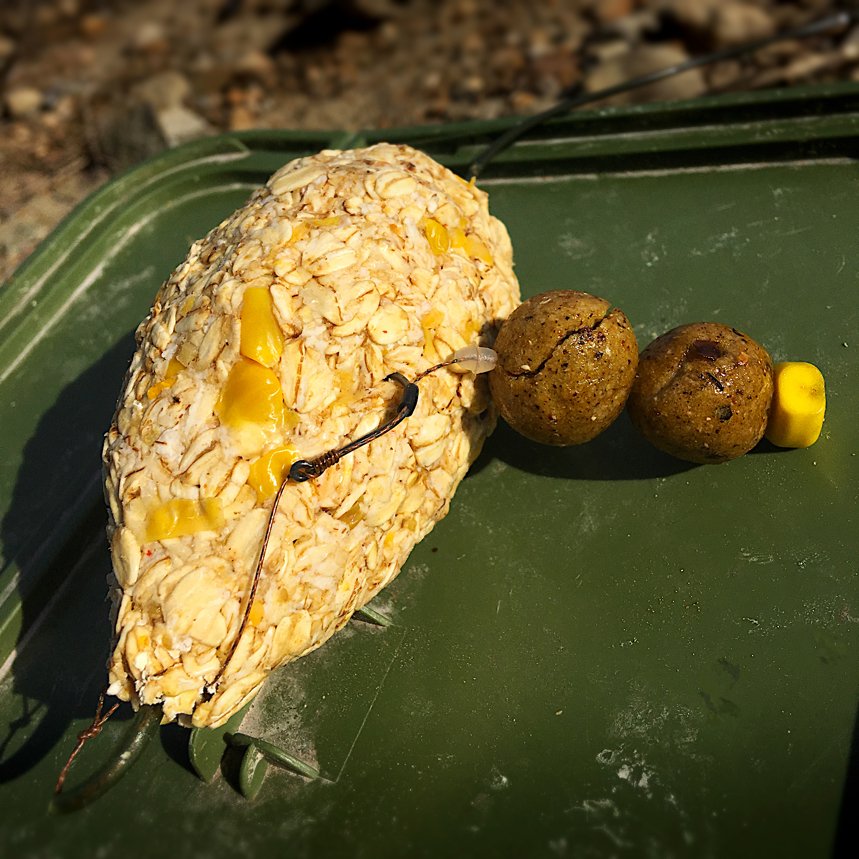

One last tip for this month:
All the baits mentioned above can be made even more effective by introducing them as chum before your planned fishing session - (pre-baiting). This can be done the night before or the morning of…but you’ll notice an even bigger difference in your catch rate, the longer you have previously and regularly pre-baited that same spot…
Check with your State’s Fish & Game Department' rules governing whether chumming is legal in your area. A few States or certain waters within specific States do ban the use of Corn/Maize completely, even as a hook bait. So please check your local regulations very carefully.
That’s it for this month, I hope you’ve picked up some useful information here. I’m looking forward to peeling back even more carp angling “mysteries” next month for you…
About Our Organization:
The American Carp Society was formed in 2002, with the goal of promoting and educating the public on the sport of specimen Carp Fishing in the USA.
The Common Carp (cyprinus carpio) is one of the hardest fighting freshwater fish in the world and is now being pursued by anglers of all persuasions, from fly fisherman to dedicated Specialist Carp anglers as a sport fish. The American Carp Society is a membership based organization and is responsible for promoting the sport and ensuring careful stewardship of both the specimen fish and its environment for the future generation of American Carp Anglers.
Website: www.americancarpsociety.com
Email: info@americancarpsociety.com
Instagram: www.instagram.com/american_carp_society



